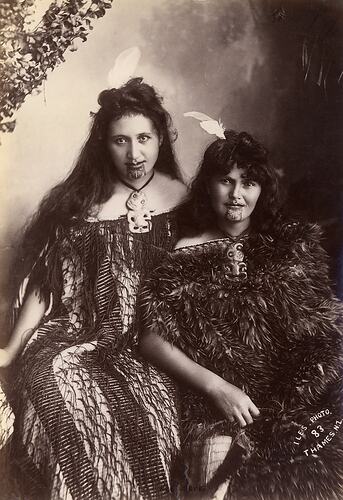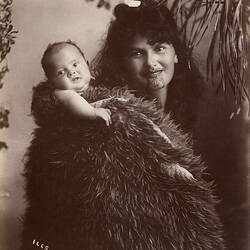Ko Kapu Te Rangi te Maunga
Ko Ohinemataroa te Awa
Ko Mataatua te Waka
Ko Ngati Awa te Iwi
Ko Ngati Hokopu te Hapu
Ko Te Whare o Toroa te Marae
Ko Wairaka te Whare Tipuna
Ko Tamatea Ki Te Huatahi te Wharekai
Ko Te Manuka Tutahi te whenuaKapu Te Rangi is the mountain
Ohinemataroa is the river
Mataatua is the canoe
Ngati Awa is the tribe
Ngati Hokopu is the sub-tribe
Te Whare o Toroa is the marae
Wairaka is the meeting house
Tamatea Ki Te Huatahi is the dining hall
Te Manuka Tutahi is the land. [1]
Ngati Hokopu Pepeha. (A 'pepeha' is an introduction that establishes identity and heritage).
This photo depicts my great grandmother Ani (née Melbourne/ Milburn) Doherty (1863-1929) - on the right - and Emere (née Apanui, Mair) Stewart (1870-1957) - on the left.
The Museums Victoria catalogue entry for this photo describes how the photographer, Arthur James Iles (1870-1943), was able to recruit some of the Maori subjects who appear in his photos through his first Maori wife Rebecca (Ripeka) Elsie Rangimahora Utuatonga (1872-1938) and also through his relationships with people such as soldier, surveyor, interpreter, and Maori Land Court judge Captain Gilbert Mair (1843-1923). Emere was the daughter of Raiha Apanui and Major William Mair - the brother of Gilbert Mair.
Iles' photography studio at this time was in the Coromandel peninsula town of Thames. There were steamer boats which provided a transport link with Whakatane in the eastern Bay of Plenty where Ani and Emere grew up. In 1891 Emere married Heta Rewiti (Heta David Stewart) and they lived at Thames. (See also the family reunion book: Heta Rewiti & Emere Apanui Stewart: Whanau reunion January 2000. [Whakatane, 2000.] [2]
A publication on the history of NZ photography by Michael Graham-Stewart and John Gow states that: ".by the age of twenty-three . [Iles] had opened a studio in Pollen Street, Thames, specialising in Maori portraits. Some of his most impressive sitters were bought to him by Gilbert Mair." [2006: p. 92]
A blog entry/webpage on Early New Zealand photographers includes this description of Iles' Thames, Pollen Street studio:
"In the studio, which adjoins the dressing room, the arrangements made to secure good photographs being obtained are most complete. The size of the room is 35ft x 14ft. For lighting, a skylight and side windows are used, and the liberal employment of blinds and curtains, enables the operator to throw the light upon any part of the studio he desires to do, and to increase it, or decrease it, at will. A large camera stands in the middle of the room, fitted with the most recent improvements for securing instantaneous photographs. Thames Star, Volume XXIV, Issue 7473, 17 July 1893, 'New Photographic Studio.'"
I have seen this photo described on other websites and elsewhere as being of 'Sisters' and these women were indeed 'whangai' (fostered, adoptive) sisters, fostered by Wepiha Apanui and his wife Huhana Te Waihapuarangi who had no birth children, along with other children including: Ani's brother George Hori Wepiha Melbourne, Reremoana (Rose) Bluett and Te Whanoke Rakuraku.
Raiha Apanui was the sister of Wepiha Apanui so Emere was also his niece.
Wepiha was one of the leaders of Ngati Awa, the iwi (tribe) based at Whakatane. He was also a carver who led the production of the beautiful whare (carved houses): Hotonui (Auckland War Memorial Museum) and Mataatua, now fittingly re-established in central Whakatane. Huhana was an interpreter in the Maori Land Court and acted as Wepiha's secretary in his correspondence with government figures.
The other photograph of my great grandmother and great uncle was made by Iles at this time. It depicts Ani with her son Adrian (aka Bob, Karenama) carried on her back. The family believes that the baby in this photo is Bob and he was born in 1895, which, if correct, dates the photographs to 1895. Both photos seem to have been taken in the same studio setting, at the same time, and there are several other Iles photos from this time which feature the same studio set-up. The Museums Victoria entry referred to states that, in 1895, Iles closed his Thames studio and moved from Thames to the Bay of Islands in the north of New Zealand. [3]
Ani's birth mother was Motoi (Peata) Aperahama Hara, so this pepeha (below) applies to Motoi (and indirectly, to Ani):
Ko Tuhoe te Iwi
Ko Ngati Tawhaki te hapu
Ko Maungapohatu te Maunga
Ko Ohinemataroa te awa
Ko Te Whaia-te-motu te marae
Ko Ngaputahi te kainga
The Tribe is Tuhoe
Ngati Tawhaki is the Sub-tribe
Maungapohatu is the mountain
Ohinemataroa is the river
Te Whaia-te-motu is the marae
Ngaputahi is the home [4]
There are several other photos of Emere Stewart throughout her life available at the website of the Auckland War Memorial Museum as part of the 'Paumea Horton McKay Collection' of photographs. [5]
This collection is described as being a large "... collection of photographic prints, mainly portraits, relating to the McKay, Crapp and Stewart families of Bay of Plenty." Images of some of my great aunts and great uncles (Ani's children) also appear in this collection.
Parts of the Doherty family history described above are also discussed in the publication:
Helen Park (1978) Identity: A brief history of Ani & Edward (Ted) Doherty's family and souvenir of the family reunion held at Wairaka Marae, Whakatane, on Auckland Anniversary Weekend, 28-30 January 1978. Auckland, Self published. (Republished with some additional information by Stephen Park, Auckland, 2013).
My second cousin Helen interviewed my great aunts, Milly (Amelia) and Agnes, my grandmother Cis (Cecilia) and great uncle Bob, for this publication and they all attended the reunion, as did my cousins and I.
Wayne Carter, March 2022.
-------
ENDNOTES
1. Website for Te Whare o Toroa Marae: http://www.wairaka.maori.nz/
2. Mary Lawson-Nuri [and Bradford Hami] (2000) Heta Reweti and Emere Apanui Stewart: whanau reunion January 2000 [Whakatane, N.Z.] [Whanau Reunion Committee], [2000].
3. For more information about this photograph also see: https://natlib.govt.nz/records/22475985
4. Doherty, Wiremu (2010). Matauranga Tuhoe: the centrality of Matauranga-a-iwi to Maori education. Auckland: University of Auckland (Doctoral dissertation). Page 217.
5. https://www.aucklandmuseum.com/collection/object/am_library-photography-66154
REFERENCES
Michael Graham-Stewart, John Gow (2006) Out of time: Maori & the photographer 1860-1940: the Ngawini Cooper Trust collection. Auckland, N.Z. : John Leech Gallery, 2006.
'Early New Zealand photographers and their successors - Iles, Arthur James.'
https://canterburyphotography.blogspot.com/2016/11/iles-athur-james-iles.html
More Information
-
Keywords
-
Authors
-
Article types


